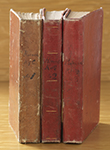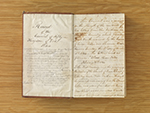
The publication of the Council of Fifty minute books by the Joseph Smith Papers project is one of the most profound achievements of the years-long effort by the Church History Department to make available to everyone all of Joseph Smith’s papers. The Council of Fifty minutes have never before been published or made publicly available, but can now be accessed readily by both academics and interested Church members alike. Many nonacademics will likely have never even heard of the Council of Fifty, as it was only in effective operation in the Church for a very brief time.
By late 1843 and early 1844, it had become apparent to Joseph Smith that the Latter-day Saints would not be able to live peaceably inside the boundaries of the United States. Mormons had been massacred and brutalized in Missouri in 1838 and had all of their property confiscated without remuneration. Efforts to obtain redress of their grievances were pursued at the local, state, and federal levels, with even the president of the United States refusing to intervene on the Mormons’ behalf. In Nauvoo, the growing Mormon population and thier subsequent power were engendering the kind of anti-Mormon sentiment that had led to the Missouri expulsion a few years earlier. Joseph Smith had personally written to the various presidential hopefuls of the Democratic and Whig Parties, asking if they would work on behalf of the Mormons to help them obtain the land taken from them. Each responded by stating they either could or would do nothing for the Mormons in their plight. As a result, Joseph Smith declared himself a candidate for president in hopes that such a move might bring more attention to their cause.
Yet by February 1844 Joseph had apparently already made the decision that the Mormons needed to move outside of the borders of the United States. His journal recorded, “I instructed the 12 to send out a delegation— & investigate the Locations of Californnia & oregon & find a good Location where we can remove after the Temple is completed & build a city in a day and have a government of our own in a healthy climate.”[1]
A few weeks later, on 11 March 1844, Joseph Smith organized the group that would come to be known as the Council of Fifty. The council’s purpose was to “look to some place where we can go and establish a Theocracy either in Texas or Oregon or somewhere in California . . . and [form] a constitution which shall be according to the mind of God and erect it between the heavens and the earth where all nations might flow unto it.”[2] The council was to begin to establish the political Kingdom of God on earth just as the Church worked to bring to pass the religious purposes of God, preparatory to the millennial reign of Jesus Christ. During the second meeting of the council, Joseph Smith received a revelation declaring the name of the council to be “The Kingdom of God and his Laws, with the keys and power thereof, and judgement in the hands of his servants. Ahman Christ.”[3]
The long-term goal of the council was to establish a government that would be prepared for Christ to assume the head of once he returned and began his millennial reign. The short-term goals surrounded organizing the electioneering efforts for Joseph Smith’s presidential campaign and seeking out a place where the Saints could move to set up their own government and flee persecution.
The council, for instance, initiated negotiations with President Sam Houston of the Republic of Texas in the spring of 1844. Houston for a time seemed to seriously consider allowing the tens of thousands of Mormons to settle in the sparsely populated west Texas. He saw the Mormons as a potential buffer to continual Mexican military incursions and the constant threat that Mexico might settle its own internal political discord long enough to mount a sustained campaign against the renegade province whose independence they did not recognize. The council also sent emissaries to negotiate with several different Indian tribes for two reasons. Not only were they considering settling on Indian land, at least temporarily, but they also anticipated sweeping success spreading the gospel among the Indians as latter embraced the Book of Mormon as a story of their ancestors.

William Clayton took careful minutes of the meetings and the resulting record is a treasure trove of statements and insights from early Church leaders, including Joseph Smith and Brigham Young. Joseph Smith, for instance, spoke several times at length on the principles of religious freedom and admonished the men present to never allow themselves to be intolerant of the religious views of others. Well known for his willingness to allow pastors from other religions to preach in Nauvoo and frustrated that their religion had so often been maligned and attacked by bigots who refused to let them worship as they chose, Joseph Smith did not want such intolerance to ever manifest itself among Mormons building the Kingdom of God. He explained to the men, “When I have used every means in my power to exalt a mans mind, and have taught him righteous principles to no effect [and] he is still inclined in his darkness, yet the same principles of liberty and charity would ever be manifested by me as though he embraced it.”[4] Joseph explained further that “God cannot save or damn a man only on the principle that every man acts, chooses and worships for himself.”[5] One quality often manifested by Joseph was his love of people and how much he treasured friendship. At one point, in what could be seen as a premonition of his own rapidly approaching demise, Joseph said, “The only thing I am afraid of is, that I will not live long enough to enjoy the society of these my friends as long as I want to.”[6]
On another occasion, Brigham Young gave a passionate oration on the importance of accepting and following Joseph Smith as the prophet of the Church. In so doing he taught a principle about the way revelation is given: “He supposed there has not yet been a perfect revelation given, because we cannot understand it, yet we receive a little here and a little there. He should not be stumbled if the prophet should translate the bible forty thousand times over and yet it should be different in some places every time, because when God speaks, he always speaks according to the capacity of the people.”[7]
The Council of Fifty minutes contain many discussions about methods and means of escaping the growing violence and animosity directed toward the Church. That violence culminated in the assassination of Joseph and Hyrum Smith, something that William Clayton bitterly reflects upon in the book. He also narrates the events that occurred leading up to their murders and provided a description he had garnered from eyewitnesses about what occurred in Carthage Jail that day. This account is a previously unknown description of the martyrdom of Joseph and Hyrum Smith.
After Joseph’s murder, the feeling among the council members that the Church must escape the boundaries of the United States in order to have peace was only magnified and several of the men reflected bitterly on the loss of their prophet and the continued threats of violence. John Taylor, himself savagely wounded in Carthage Jail while under the promised protection of the State of Illinois, expressed his frustration, “In regard to the situation of the world as it now exists I don’t care a damn because they are as corrupt as the devil. We have no benifit from the laws of the land. . . . Some cry out it will bring persecution, but they cannot lie about us, nor persecute us worse than they have done.” Fully supporting the plan to leave the nation and find refuge, Taylor asserted, “We know we have no more justice here, no more than we could get at the gates of hell, and the only thing we have got to do is to take care of ourselves.”[8]

For many of these men and many Mormons outside of the council, American democracy had failed them. As a despised minority group, the Mormons were always at the mercy of the tolerance of the majority populations in New York, Ohio, Missouri, and Illinois. When antagonism led to violence, the Saints found time and again local and state authorities unwilling to intervene to protect them in their perceived rights and unwilling to fully allow the Mormons to defend themselves from such violence. That failure of democracy was poignantly visible as the bullet-ridden, murdered bodies of Joseph and Hyrum Smith were returned in a wagon from Carthage only days after having surrendered to the governor’s troops with the promise that their lives would be protected. As Clayton wrote in the minute book of the reaction to the murders, “I need not state the sorrow of this people when informed of the fact the following morning. an universal feeling of gloom and anguish prevailed.”[9]
The Council of Fifty minutes published in Administrative Records, Council of Fifty, Minutes, March 1844–January 1846 by the Joseph Smith Papers provides readers insights into the personalities, fears, ideas, and faith of the men in the council. The volume offers a rare look into the discussions and debates of prominent Church leaders during one of the most volatile periods of early Church history. The volume will not only provide a better understanding of the events and decisions that led to the exodus from Nauvoo but also allow readers to better know the men involved in these meetings and feel in some measure their passions, anxieties, and desire to build up the Kingdom of God on earth.[10]
Joseph Smith Papers, Administrative Records, Council of Fifty, Minutes, March 1844–January 1846. Edited by Matthew J. Grow, Ronald K. Esplin, Mark Ashurst-McGee, Gerrit J. Dirkmaat, and Jeffrey D. Mahas, Church Historian’s Press, 2016.
Notes
[1] Andrew H. Hedges, Alex D. Smith, and Brent M. Rogers, eds., Journals, Volume 3: May 1843–June 1844, 20 February 1844, 181.
[2] Matthew J. Grow, Ronald K. Esplin, Mark Ashurst-McGee. Gerrit J. Dirkmaat, and Jeffrey D. Mahas, eds., Administrative Records, Council of Fifty, Minutes, March 1844-January 1846, 11 March 1844, 42.
[3] Ibid., 14 March 1844, 48.
[4] Ibid., 11 April 1844, 100.
[5] Ibid., 97.
[6] Ibid., 100.
[7] Ibid., 18 April 1844, 119.
[8] Ibid., 1 March 1845, 264-265.
[9] Ibid., Events of June 1844, 204.
[10] The Religious Studies Center is publishing (2017) a collection of essays examining how the Council of Fifty changes our understanding of Mormon history. This book will examine some of the key items covered in the minutes in a more digestible, narrative way. It is tentatively entitled Matthew J. Grow and R. Eric Smith, eds., The Council of Fifty: What the Records Reveal about Mormon History.
